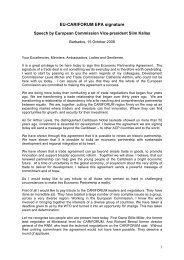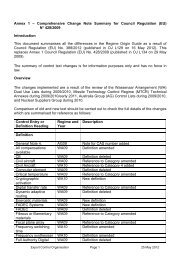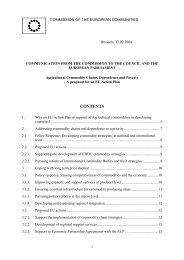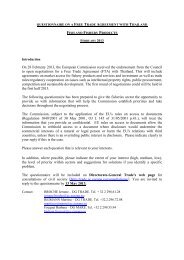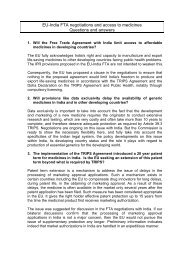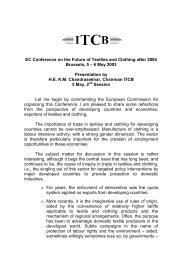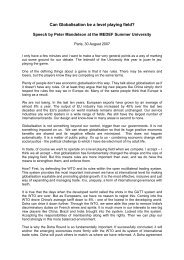Report on the Implementation of the derogation to ... - Trade Websites
Report on the Implementation of the derogation to ... - Trade Websites
Report on the Implementation of the derogation to ... - Trade Websites
You also want an ePaper? Increase the reach of your titles
YUMPU automatically turns print PDFs into web optimized ePapers that Google loves.
Final <str<strong>on</strong>g>Report</str<strong>on</strong>g><br />
RoO Derogati<strong>on</strong> under <strong>the</strong> PACP-IEPA<br />
very few PNG nati<strong>on</strong>als have been employed or promoted in<strong>to</strong> management-level positi<strong>on</strong>s within<br />
<strong>the</strong> canneries. 68 However, <strong>the</strong> majority <strong>of</strong> supervisory level positi<strong>on</strong>s are filled by PNG nati<strong>on</strong>als.<br />
Worldwide, tuna canneries are large-scale employers <strong>of</strong> female workers in unskilled, producti<strong>on</strong>level<br />
positi<strong>on</strong>s, particularly skinning and loining. At least 70% <strong>of</strong> workers in PNG canneries are<br />
female; 80-90% <strong>of</strong> whom are unskilled and employed in producti<strong>on</strong> lines.<br />
Given <strong>the</strong> labour-intensive nature <strong>of</strong> work within tuna processing facilities, coupled with difficult<br />
working c<strong>on</strong>diti<strong>on</strong>s (i.e. standing for l<strong>on</strong>g periods each day, working in hot/damp c<strong>on</strong>diti<strong>on</strong>s),<br />
canneries actively seek young, fit workers, aged 18 years and over. At a minimum, around 50% <strong>of</strong><br />
workers are within 18-35 years <strong>of</strong> age. In <strong>the</strong> case <strong>of</strong> SSTC and RDTC, at least 80% <strong>of</strong> workers are<br />
between 18-35 years <strong>of</strong> age. Generally, <strong>the</strong> maximum age for producti<strong>on</strong>-line workers is around 45<br />
years old.<br />
High levels <strong>of</strong> absenteeism and staff turnover are serious issues for PNG canneries (discussed fur<strong>the</strong>r<br />
in Secti<strong>on</strong> 4.4.2). Currently, absenteeism levels range from around 20-30%. To manage this, PNG<br />
canneries employ up <strong>to</strong> 30% more workers than <strong>the</strong> actual level <strong>of</strong> producti<strong>on</strong> warrants. Staff<br />
turnover is as high as 50-60% and is evidenced by <strong>the</strong> large proporti<strong>on</strong> <strong>of</strong> <strong>the</strong> workforce employed<br />
for less than 12 m<strong>on</strong>ths (40-85%). Canneries report that staff turnover levels are heavily influenced<br />
by interrupti<strong>on</strong>s <strong>to</strong> producti<strong>on</strong>. When interrupti<strong>on</strong>s are low, staff turnover levels may be around<br />
10%; with interrupti<strong>on</strong>s <strong>to</strong> producti<strong>on</strong> due <strong>to</strong> issues like power and water outages, turnover is much<br />
higher.<br />
Table 4.5 presents a comparative labour pr<strong>of</strong>ile for PNG’s three tuna processing operati<strong>on</strong>s, as at<br />
September 2011.<br />
68 A similar case exists for crews <strong>on</strong>board fishing vessels.<br />
Linpico s.a.r.l. Page 53




